Deciding what bit to use with an off-track Thoroughbred may seem daunting to some, but longtime horseman Karen Hornyak has it down to a science.
In this week’s Clubhouse Q&A, Hornyak describes her go-to bits, and the reasons for each. She enlightens us on how she achieves the perfect not-too-small, not-too-big fit.
Q: Karen, with over 20 years experience finding the right bit for each horse, what are some of the guidelines you use?
The first thing I consider is the length of the bit. I find that 5 ¼ inch is a good size to start with for most TBs. I’ll try that, and then check to see if the bit is pinching the corners of the mouth (too short) or protruding excessively on the sides (too long). Given that I have a nice selection of bits of various sizes, I’ll adjust up (rarely down) in quarter-inch increments until I get the best fit possible. I don’t like to see a lot of metal sticking out on the sides, but in the absence of a perfect fit, a bit that is just a little too long can still be comfortable and effective; one that’s too short will certainly be uncomfortable for the horse and will probably cause sores.
Once I’ve determined the correct length, I look at the width (thickness) of the bit. In my experience, a medium width will suit most TBs, so that’s where I start. I slip a finger into the corner of the horse’s mouth (to encourage him to open it) and look at how the bit is seated on the bars. If the bars are very narrow, without a lot of clearance between the teeth, I might use a thinner bit; conversely, if the horse has a larger mouth, I’ll try a thicker one. Although new bits frequently come tagged with the sizing in millimeters, I can’t say I’ve paid much attention to that–probably because I was fitting bits before I knew about the numbers!
There are commercially manufactured bit sizing devices available nowadays that can take some of the guesswork out of it, but I’ve never had the opportunity to use one (although on rare occasions I’ve been known to rig up a facsimile with baling twine!) As far as I know, these bit gauges are made for determining only the optimum length, not the width. As for the weight of the bit, I just go with standard/medium; I’ve never found a reason to deviate from that.
To me, it’s important to find a bit that is not only a technically correct fit but also is one that the horse is comfortable with. Once I think I’ve found the right fit, I’ll lunge (single or double line) and/or ground drive the horse and make note of his reaction. Excessive chewing, head shaking or flipping, and similar behaviors don’t necessarily mean a poor fit, but they’re all signs that further evaluation (of the size or type of bit, or the adjustment of the bridle) would be prudent.
Q: What bit has worked best with your OTTB?
Of all the bits I’ve tried–and there were many–the double-jointed snaffle (DJS) is the one I keep coming back to. Mine happens to be a loose ring French Link, but I also like the half moon and most other variations.
I don’t have a marked preference between egg butt and loose ring, as there are benefits to both.
However, I most definitely prefer the DJS to the single-jointed snaffle (SJS), for several reasons.
First, unless the SJS is a “pinch-less” style, there will be a nutcracker action (and thus some degree of pinching) of the tongue.
A bit that causes pain or discomfort is a barrier to communication rather than an aid. The DJS breaks over the tongue in two places, so that problem is eliminated.
Second, the SJS, despite its nutcracker action, acts primarily on the corners of the mouth until considerable pressure is exerted; whereas a DJS distributes the pressure between the tongue and the corners of the mouth at any pressure.
An exception to this is the Dr. Bristol, which concentrates pressure on the tongue, and which I’ve rarely had cause to use.
My OTTB is much more comfortable in his DJS than the SJS, which translates as better communication with a willing partner. The majority of racehorses are ridden in some form of SJS. They are taught to lean into the bit for balance and can easily become physically or psychologically “numbed” to the pressure of the bit.
I’ve found that the change in pressure distribution afforded by the DJS will “re-sensitize” an old campaigner to the bit, yet it is gentle enough for a soft-mouthed youngster as well.
My other go-to bit is a Pelham with a half-moon link.
Double-jointed Pelhams are a little hard to find but well worth the effort. I use this leverage bit to make a stronger statement without pulling harder—particularly for the jumping phases of eventing. Ideally, my horse will reliably rate or stop with a snaffle bit, in response to the correct combination of lightly-applied aids, in any given situation. However, in the “real world” we know this is not always the case!
I could write pages just comparing the DJ Pelham to other bits, but here’s why I like it, in brief: It has the same comfort factor as a DJS; and, it is more effective than the Kimberwicke (for turning and communication in general, as well as stopping).
I like its ability to control the amount of leverage by using more or less curb rein while maintaining contact with the snaffle. I also admit to using bit converters with my Pelham for cross country. What I lose in finesse, I gain in simplicity, and the combination suits both me and my OTTB quite well. While I maintain that “bit” is not an exact synonym for “brakes,” there is still much to be said for completing XC with one’s shoulders still in their sockets!
I think the biggest thing to keep in mind when deciding which bit to use for your OTTB (besides fit) is that despite their size and energy, Thoroughbreds are very sensitive. Even the heavy draft horses, with their thick coats and relatively thick skins, can feel a fly when it alights upon them.
Think of how much more sensitive, then, are the thin-skinned, fine-coated Thoroughbreds! This sensitivity is what makes them so reactive, but given proper direction this is a blessing, not a curse. TBs will respond to a “whisper,” so there’s generally no need to “shout.” Most OTTBs are intelligent, willing partners who would rather work than “play”—provided they enjoy the job. “Control” of a TB happens in the horse’s mind; the bit is only a tool that provides a common language.
The severity of a bit determines whether you communicate in a whisper or a shout.
Q: How do you balance the rider’s desire to know there are brakes available, against the horse’s need to be comfortable and not have his mouth yanked?
With education! No one should hop aboard a horse without having some idea how to communicate with it properly. No horse or rider should be purposely put into a situation they are physically or mentally unable to deal with.
Systematic training—delivered with kindness and empathy—is the only method I recommend for instilling confidence in horse and rider alike.
So many riders don’t understand that it isn’t the bit that stops the horse.
The rider must be trained to use the correct signals (aids) and the horse trained to respond reliably to those signals.
A harder pull or more severe bit will emphasize the rein aids, but ultimately there are no “brakes” strong enough to stop a horse that doesn’t want to stop!
In fact, due to its race training, pulling harder on an OTTB’s reins will likely be interpreted as “go faster.”
Indiscriminate yanking on a horse’s mouth (not to be confused with a single sharp “check” if the situation warrants) is an option I simply don’t give to anyone who rides a horse on my watch. It’s for good reason that reputable OTTB rescue organizations recommend/require that potential adoptees be experienced riders!
Bit kindly, ride gently, train well. These wonderful horses have a lot to teach us–once we learn to listen.
Q: What is your background with horses? Have you owned an OTTB for a long time, and, what has been the highlight of your relationship as a horse/rider team?
I’ve been speaking as if I still owned and rode my OTTB, but in fact I lost him about a year and a half ago (he was 25). I have a degree in Equestrian Studies and have worked professionally in the horse industry as a trainer, instructor, barn manager, groom, night watch person, and (informally) as a consultant. I’m currently a part-time data editor for the website Horse Racing Nation.
It was during my five years at a TB breeding & training farm that I met the OTTB who became the love of my life. I’m tempted to say that the highlight of our relationship was simply the fact that it came to be.
I was so thrilled to have my own horse; and not just any horse, but a Thoroughbred! His name was Wesley (Western Adversary), and he taught me so much in our 20 years together; I could (and someday may) write a book. I didn’t feel so much that I owned him, as that I was the caretaker of royalty.
When Wes turned 20, I tried to retire him, thinking it would be better for his health. I had my own health issues and had gained a considerable amount of weight—too much, I thought, to ask my aging OTTB to carry.
He was miserable and let me know it! Long story short, Wes came out of retirement, and we, the old horse with the fat rider, found ourselves competing in local mini-trials, and loving it! I’ll never forget the day we placed second in our division.
After dressage and stadium, Wesley was still eager and full of energy, but he was soft in my hands. It was as if we saw through the same eyes, two spirits melded into one as we flew over the XC course.
Later I saw pictures that showed how bright his 23-year-old eyes were that day. Wes was the epitome of Thoroughbred spirit and heart, just as that ride was the epitome of what the relationship between horse and rider could be.
It was only a red ribbon in Very Green, but it felt like an Olympic gold.
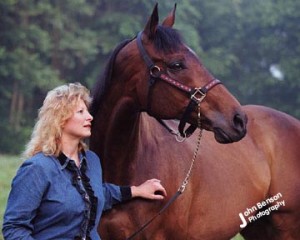
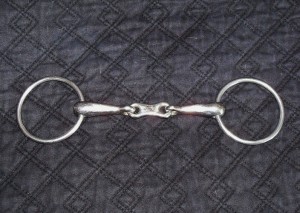
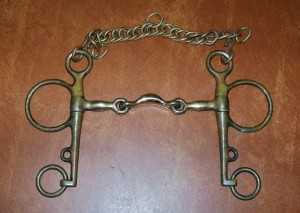
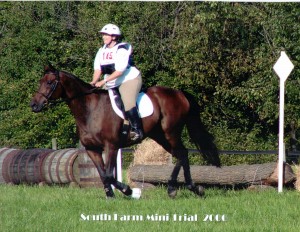
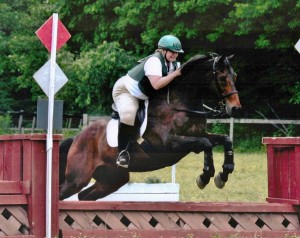


hi there everyone
my tb mare ” lady chocolate ” is of course as we all say my best friend… I use a brass elyptical bit on her as I was told by instructor that it is very kind and gentle… but she shows teeth , pulls at the bit and a few times pulls so much that I loose reigns and throws her head a clear sign she not liking it .. I been told to push through . .. I need advice plzzzz
My lovely off-track mare Charm…(racing name Comedy Flyer) goes bit-less. Bits are ok in the QUIET hands of kind experienced riders….but so many horse are victims of hands that cause unnecessary pain. Charm loves her bit-less bridle ….she has never run off with me. I ride bit-less because I do not have quiet hands & my riding needs improvement…. there is no need to take my inexperience out on her. Charm pays me back by being amazing…go bit-less……your horse will love it!
That’s so kind of you and so great that she responds to a bitless bridle. I’ll ride my OTTB in an English hackamore every so often and it does help me ride better through my seat and leg aids and less with my hands. Several OTTB jumping horses also go well without a bit: Courageous Comet comes to mind 🙂
Wow,,Karen so proud of u…!!
I have a comment about the French link v. Dr. Bristol, and that is the misconception as to how they act. If you look at the picture of the French link shown in the article, it makes you think that the link lies flat on the tongue, but the picture shows how the bit lies *on a flat surface*, NOT how it hangs in the mouth of the horse. In the horse’s mouth, the flat/narrow edge of the link is in contact with the tongue. Confirm this yourself by holding by the crown piece a bridle fitted with a French link snaffle and letting everything hang or, better yet, with your horse wearing this bit, lift the lip at the commissure and take a peek in your horse’s mouth (do not open the mouth and the movement will make the bit move). Many bits with a flat, square middle link are MISLABELED as Dr. Bristol bits, which is incorrect. The true Dr Bristol bit has a slight twist to the two lateral arms of the mouth piece, so the rings to which the link is attached are near to the same plane as the snaffle rings (and not at 90 degrees as shown in the picture above). A true Dr Bristol bit has the central plate FLAT against the tongue, not on its edge – they are VERY hard to find. I know this will be very hard to believe because the misconception about the French link has been repeated over and over by people, in books, and so on. LOOK in your horse’s mouth, as the author of the book recommends, and you can verify how the French link sits on your horse’s tongue. That said, I know of many horses that go very well in a French link, but, to throw in a curve, my current OTTB cannot stand anything that drapes over his tongue. He is happiest with a thin mouth-pieced racing D (never mind the show hunter people decided to use the bit, changed the shape of the D rings and now call it a hunter D… it’s been using by trackers for eons!) Finally, soft hands and a balanced seat go farther to influence an off the track thoroughbred than anything you stick in its mouth. Talk to jockeys or exercise riders and they will be able to give you quite an education.
My guy goes in a French link as well, and it has been a great success. I knew him on the track, and have video of him taking the bit in his mouth, running to the front, and winning at Belmont. When I first took him over, a year past retiring, he was a head shaker. With the change in bit, and quiet consistency, no more head shaking. He listens very well now. We are almost there. But as a turf sprinter, when we see an open field, his heart can still flutter – but it is happening less and less. 😉
My OTTB goes in a happy mouth d-ring french link as her bit
What a great article and lovely story of a true partnership. Wesley was breathtaking and you two look so happy! Thanks for sharing:)
Thanks for the great article and great story! Being a relatively newer rider and horse “caregiver” – I loved how you broke down in detail how and why you choose a bit. And of course, I too was especially moved by your feelings for your great partner! Thanks again!
I’m crying . . . again. I’m one of her lucky students and I was there when they won that ribbon! Wes was truly royalty. This was a great article! I’m looking forward to more. Thank you!
What a great and informative article. Karen, thank you for sharing your knowledge, and Sue, kudos on another terrific article! It was also nice to learn about Karen’s longterm partnership with Wesley. Well done, Karen!